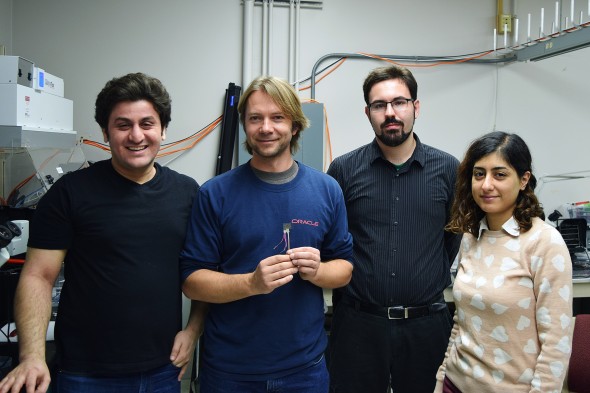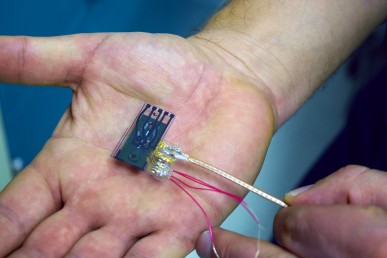Tiny sensors measure air quality in community, at work

UIC researcher Igor Paprotny (second from left), with research assistants (from left) Omid Mahdavipour, John Sabino and Dorsa Fahimi, displays the particulate-matter sensor.
Researchers in the College of Engineering and School of Public Health are collaborating on a project that can help crowd-source pollution data and make it easier to measure air quality.
Igor Paprotny, assistant professor of electrical and computer engineering, and Lisa Brosseau, professor of environmental and occupational health sciences, are working together to maximize the impact tiny sensors developed in Paprotny’s lab could have in the community and workplace.
Measuring air quality
Chicago has one of the highest asthma mortality rates in the U.S., and the incidence in children varies widely from one Chicago community to the next. But why?
It may relate to neighborhood air quality.
Paprotny plans to use the city as his laboratory and enlist community citizen-scientists to gather data with miniature personal sensors his research team is developing.

Paprotny’s team is developing a sensor the size of a memory stick that could be connected to a cellphone to measure and transmit the wearer’s exposure to hazards in the air.
Paprotny leads the Air-Microfluidics Group, a research consortium that includes UIC, Lawrence Berkeley National Laboratory, Argonne National Laboratory, the University of California-Berkeley and a scientist from the U.S. EPA. The team is developing a particulate-matter sensor the size of a memory stick that could be connected to a cellphone to measure and transmit the wearer’s exposure in real time.
Instrumentation currently used to measure particulate air pollution “is about the size of a toaster or a desktop computer,” Paprotny said.
Particulate air pollution consists of tiny particles and droplets of acids, organic chemicals, metals, soil or dust. The size of the particles is linked to their potential for causing health problems, according to the EPA, and smaller is worse. Particles under 10 microns — about one-eighth the width of a human hair — can pass through the throat, enter the lungs and cause serious adverse health effects.
When particles get really small — below 2.5 microns — “they are even more dangerous,” Paprotny said.
“They get very deep into our lungs, and we really don’t have a natural way to get rid of them,” he said. “Our immune system cannot handle them because they are too big, but they are still small enough to enter deep into our respiratory system.”
The EPA has lowered the allowable exposure limit several times, but more data is needed.
The sensor that the consortium is developing will offer not just portability, but improved accuracy and lower cost.
“Our sensor is currently the only miniature sensor that actually weighs the particles and reports the concentration as a mass,” Paprotny said.
The devices are projected to cost about $20 each to manufacture in quantity — and many will be needed.
“We’re in discussions to potentially work with Chicago environmental organizations and hope eventually to recruit citizen-scientists to wear the sensors,” Paprotny said. “With mobile sensors across the city, we can build a map of pollution and gather data.”
Workplace hazards
Brosseau, an industrial hygienist, said Paprotny’s sensors could “revolutionize” her field, which involves recognizing and controlling exposure to hazardous materials in the workplace.
In the past, workplace hazards were measured through a cumbersome device worn by the user. Then, the data needed to be analyzed manually.
“The microsensors that Igor and others are working on are really exciting because they’re tiny and have a built-in pump so you don’t need all of the paraphernalia that you used to,” Brosseau said. “You can just stick it to your lapel.”
Brosseau suggested creating wearable sensors, such as adding them to necklaces or earrings.
These sensors capture data immediately, she said.
“It contributes to the idea of citizen science,” she said. “We can potentially give tools to people in the workplace and tell them — with immediate feedback — what they’re exposed to. They don’t have to wait two weeks to have results.”
With faster results, researchers can investigate the connection between particulate exposure and health effects by collecting data on blood pressure, symptoms and more.
“It’s immediate epidemiology,” Brosseau said. “That would really revolutionize our world.”
The sensor could help individuals make healthy choices, Paprotny said.
“A portable sensor attached to a cellphone could enable all of us to scan the air around us and determine if it’s safe to go out,” he said. “We expect air around us to be clean, and it is not always the case.”
— Christy Levy contributed to this report

